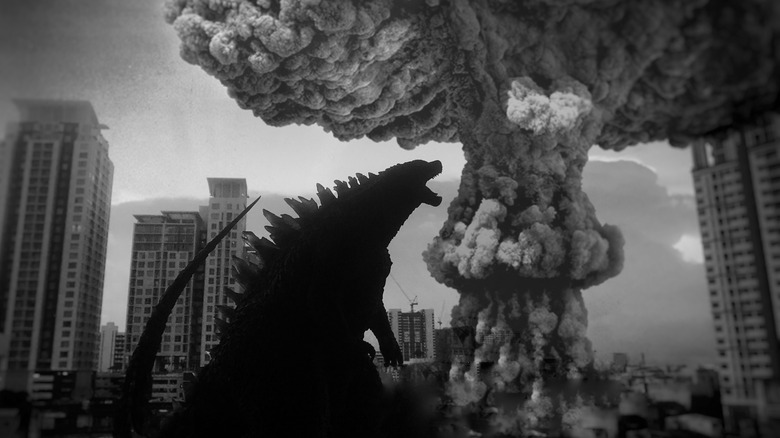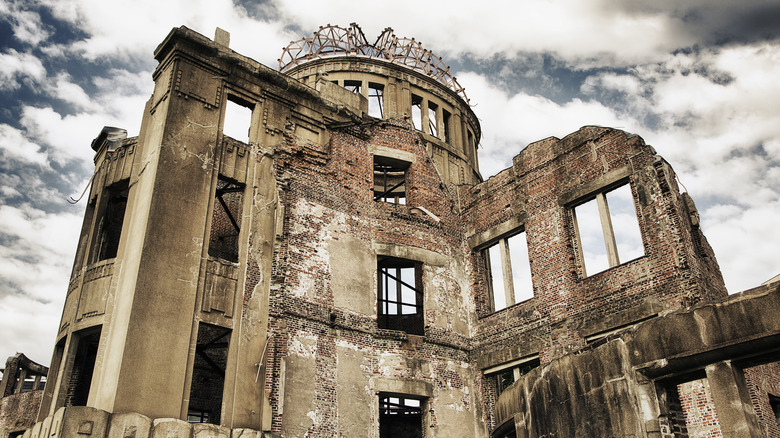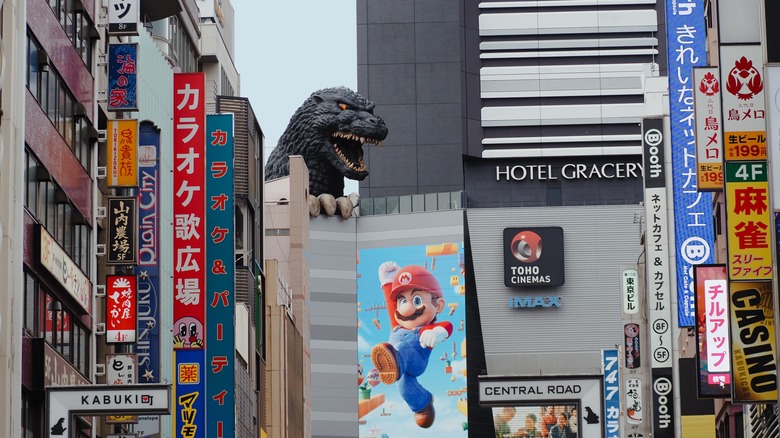The Horrifying Symbolic Origins Of Godzilla
In 1956, "Godzilla: King of the Monsters" hit U.S. theaters as an imported version of Japan's 1954 "Godzilla," or "Gojira" (ゴジラ) by the original title. Audiences outside of Japan might have tilted their heads, smirked, chuckled at the visuals, and thought nothing more than, "Haha, funny monster goes boom in funny monster flick." Few understood that the movie was a form of mourning, and a message.
A mere nine years prior in 1945 the United States had detonated the uranium bomb "Little Boy" and plutonium bomb "Fat Man" over the Japanese cities of Hiroshima and Nagasaki, respectively. Exact numbers are hard to determine, but the bombs incinerated over 200,000 people, mostly civilians, and razed both cities to the ground. Nuclear fallout riddled survivors with cancer and other diseases and their children with birth defects. Those survivors — "hibakusha" in Japanese — describe to this day horrors that only they beheld and know.
The plot of the original "Godzilla" is straightforward and even contains the precise element of national trauma that the movie intended to articulate: nuclear weaponry. In the movie, a nuclear bomb explosion awakens an ancient monster from the ocean: Godzilla. That monster, as the movie's original trailer on YouTube says, is a "titan of terror wiping out a city of 6 million in a holocaust of flame." Could things get clearer? NBC News says that moviegoers in Japan left theaters crying. And yet, the U.S. import version left out elements critical to understanding Godzilla's symbolic sociopolitical meaning.
A symbol of nuclear weaponry
William Tsutsui, author of 2004's "Godzilla on My Mind: Fifty Years of the King of Monsters," told NBC News that Godzilla was as "innocent as the kids on their playgrounds in Hiroshima." In his 1954 movie, a nuclear attack awakens the creature from his slumber in the ocean. His body is covered in the same thick, scab-like keloid scars that survivors of the Hiroshima and Nagasaki blasts bore. He's in pain — a victim seeking to destroy. He's boundless rage itself, uncorked and roving unchecked.
As Tsutsui says, the more obvious indicators of this message were excised from the U.S.' 1956 imported version of the film, such as a scene on a subway tying Godzilla to Hiroshima. In the wake of World War II, he says, "The movie [Godzilla] served as a strong political statement, representative of the traumas and anxieties of the Japanese people in an era when censorship was extensive in Japan because of the American occupation of the country after the war ended."
The nuclear attacks at Hiroshima and Nagasaki were not just a source of great pain and true horror, but "guilt and shame," Tsutsui continues. Japanese society and its creatives couldn't breach the topic directly, and so spoke through story instead. All such meaning went over the heads of American audiences. In 1956, The New York Times dismissively described Godzilla as a mere "miniature of a dinosaur made of gum-shoes and about $20 worth of toy buildings and electric train."
King of Monsters, mascot, and citizen
After decades of multimillion-dollar film projects and the rise of a globally recognized IP, Godzilla's original meaning has become lost on practically everyone. Following the success of the original 1954 "Godzilla" movie, IGN explains that TOHO Studios turned toward a financially focused sequel that established and cemented Godzilla tropes A-Z. Godzilla became a big, dumb monster that fights other big dumb monsters, stomps around cities, causes some incidental death, and is a spectacle for popcorn chewers. And yet, he still breathes "atomic breath" — a lingering reminder of his true meaning.
Nonetheless, newer Japan-made Godzilla films like "Godzilla Minus One" (not Hollywood's versions) restore the King of Monsters to a bit of his former terror — and reconnect him to World War II. He is once again, as IGN excellently puts it, "a byproduct of mankind's tampering with atomic weaponry, an abominable source of power that perverts and decays its surroundings."
In Japan as a whole, though — outside of the insights of keen filmmakers — Godzilla has become something of a mascot. His head and claw adorn the TOHO Cinema building in Kabuki-cho, Tokyo (pictured above) within the bustling nightlife area of neon-ridden Shinjuku. As the BBC reported in 2015, Godzilla even received a whole bunch of ceremonial honors from the local municipality, including gaining Japanese citizenship, becoming Shinjuku's "tourism ambassador," and showing up in man-in-suit form on a red carpet. What the remaining survivors of Hiroshima and Nagasaki think of all this is unknown.


